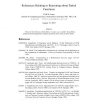ETRICS
2006
15 years 4 months ago
2006
Abstract. We provide a static analysis (using both dataflow analysis and theorem proving) to allow state changes within specifications. This can be used for specification languages...
106
click to vote
ATVA
2004
Springer
15 years 4 months ago
2004
Springer
While model checking suffers from the state space explosion problem, theorem proving is quite tedious and impractical for verifying complex designs. In this work, we present a veri...
88
Voted
ITP
2010
15 years 4 months ago
2010
Abstract. Rippling is a heuristic used to guide rewriting and is typically used for inductive theorem proving. We introduce a method to support case-analysis within rippling. Like ...
126
click to vote
PPCP
1993
15 years 4 months ago
1993
Higher-order logic programming (HOLP) languages are particularly useful for various kinds of metaprogramming and theorem proving tasks because of the logical support for variable ...
78
Voted
HICSS
1994
IEEE
15 years 4 months ago
1994
IEEE
1 This paper presents a methodology to guide equational reasoning in a goal directed way. Suggested by rippling methods developed in the eld of inductive theorem proving we use att...
86
Voted
LOPSTR
1997
Springer
15 years 4 months ago
1997
Springer
Abstract. We present an approach to a coherent program synthesis system which integrates a variety of interactively controlled and automated techniques from theorem proving and alg...
104
Voted
ECP
1997
Springer
15 years 4 months ago
1997
Springer
In 1969 Cordell Green presented his seminal description of planning as theorem proving with the situation calculus. The most pleasing feature of Green's account was the negli...
121
click to vote
TPHOL
1997
IEEE
15 years 4 months ago
1997
IEEE
This note lists references which address –in some way or another– the problems relating to formal manipulation of logical expressions where terms can fail to denote. Reference...
103
Voted
TPHOL
1999
IEEE
15 years 4 months ago
1999
IEEE
Combining theorem proving and model checking o ers the tantalizing possibility of e ciently reasoning about large circuits at high levels of abstraction. We have constructed a syst...
100
Voted
GI
2001
Springer
15 years 5 months ago
2001
Springer
We present the verification of a protocol designed to ensure self-stabilization in a ring of processors. The proof is organized as a series of refinements; it is mechanized base...



